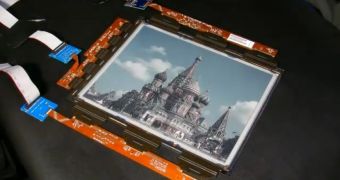Between Amazon and Barnes & Noble, there isn't much attention left in people to divert towards e-reader makers that don't have a presence worldwide, but that doesn't mean there aren't other successful products than the Kindle and the Nook.
As it happens, while Amazon's Kindle and B&N's Nook are quite popular in the US and Europe, a third party has been seeing success in Russia.
Plastic Logic is the IT player whose e-reader, Plastic Logic 100, has become a tool in Russian schools, following RUSNANO's $700 million investment last year.
What we are here to talk about now is not that e-book reader, nor some new iteration that will follow in its footsteps.
Instead, we are bringing you a prototype display that might or might not be utilized in future products.
Long story short, Plastic Logic has officially demonstrated a flexible color display with a resolution of 75 ppi (pixels per inch) and the ability to produce slightly over 4,000 hues.
For those interested in the technical details, the screen contains a total of 1.2 million plastic transistors, give or take. The actual display has a resolution of 150ppi, but the number is cut in half because the filter set on top of it needs 3 pixels to do red, green, and blue, plus a fourth, “empty” pixel (black/white).
Plastic Logic had to make the filter in such a way that it flexes at the same rate as the screen itself. This ensures a lack of distortion of the image while bending. It also ensures that neither part remains distorted.
No time frame was given for the availability of bendable Plastic Logic e-book readers. Either way, the company will have some catching up to do. After all, LG has been shipping its own 6-inch, flexible plastic screen for just a little under two months.

 14 DAY TRIAL //
14 DAY TRIAL //